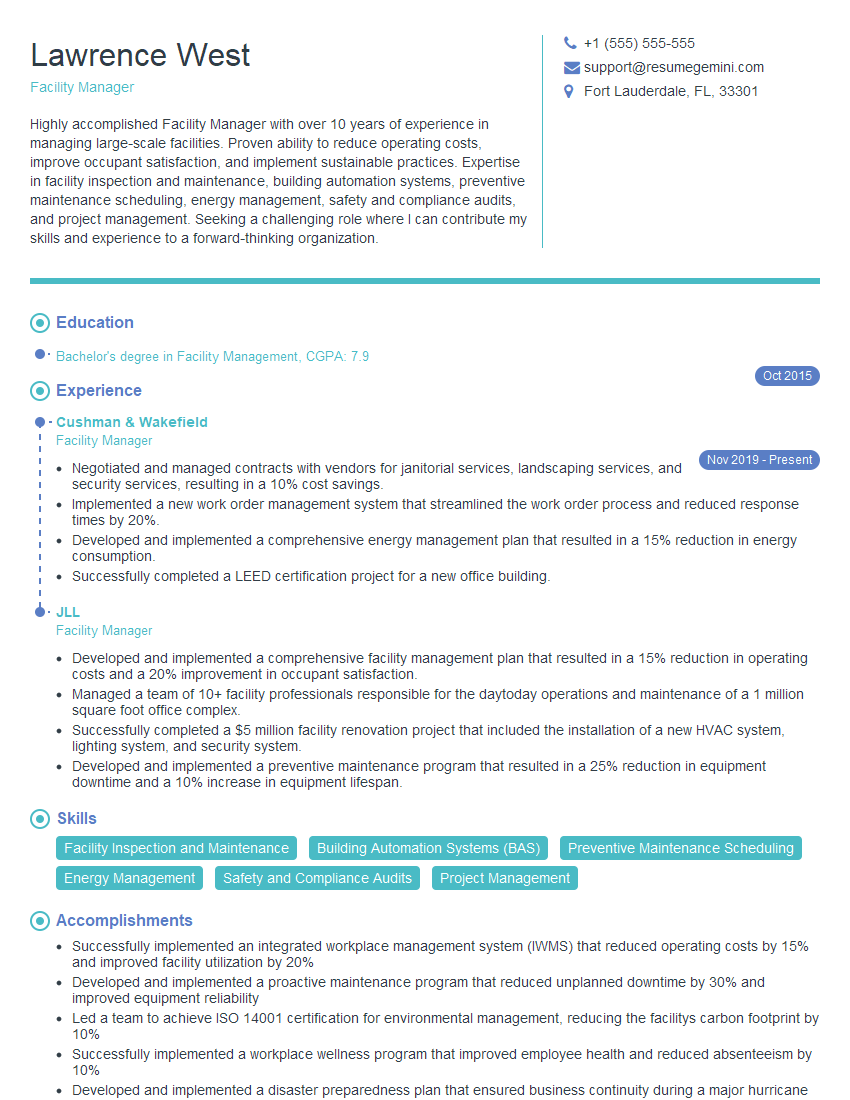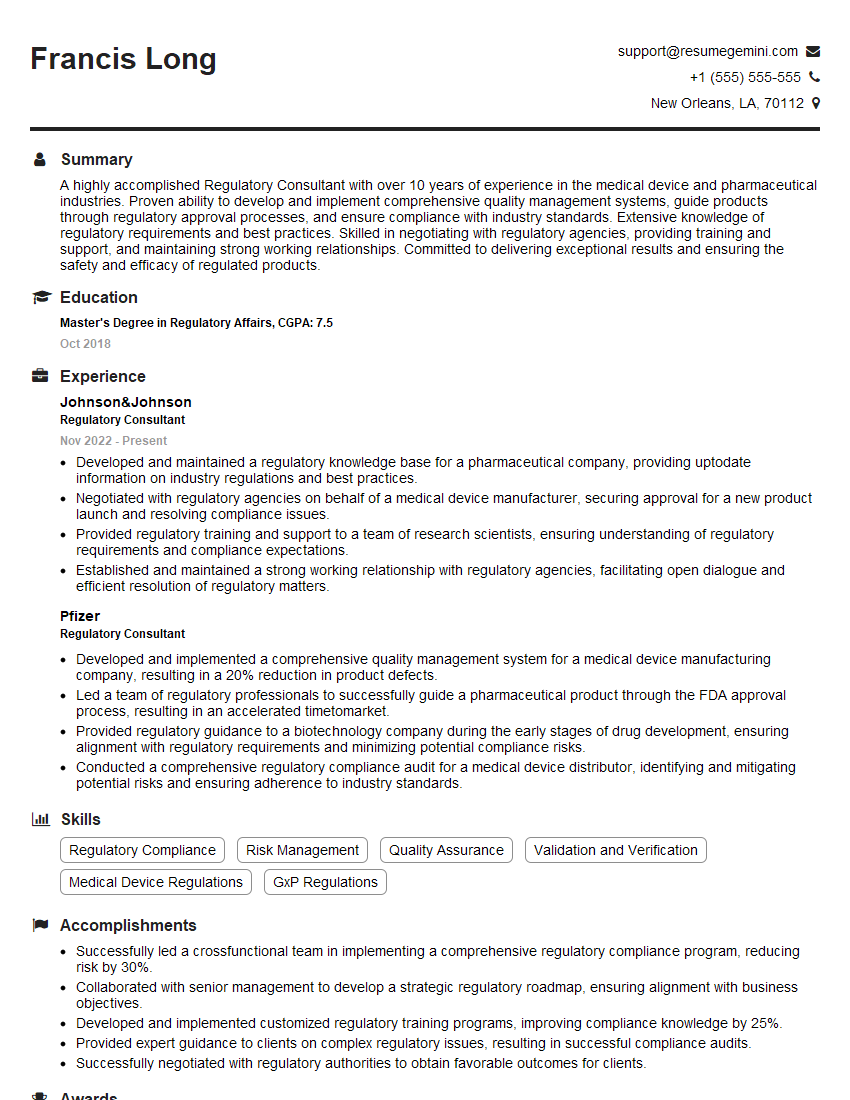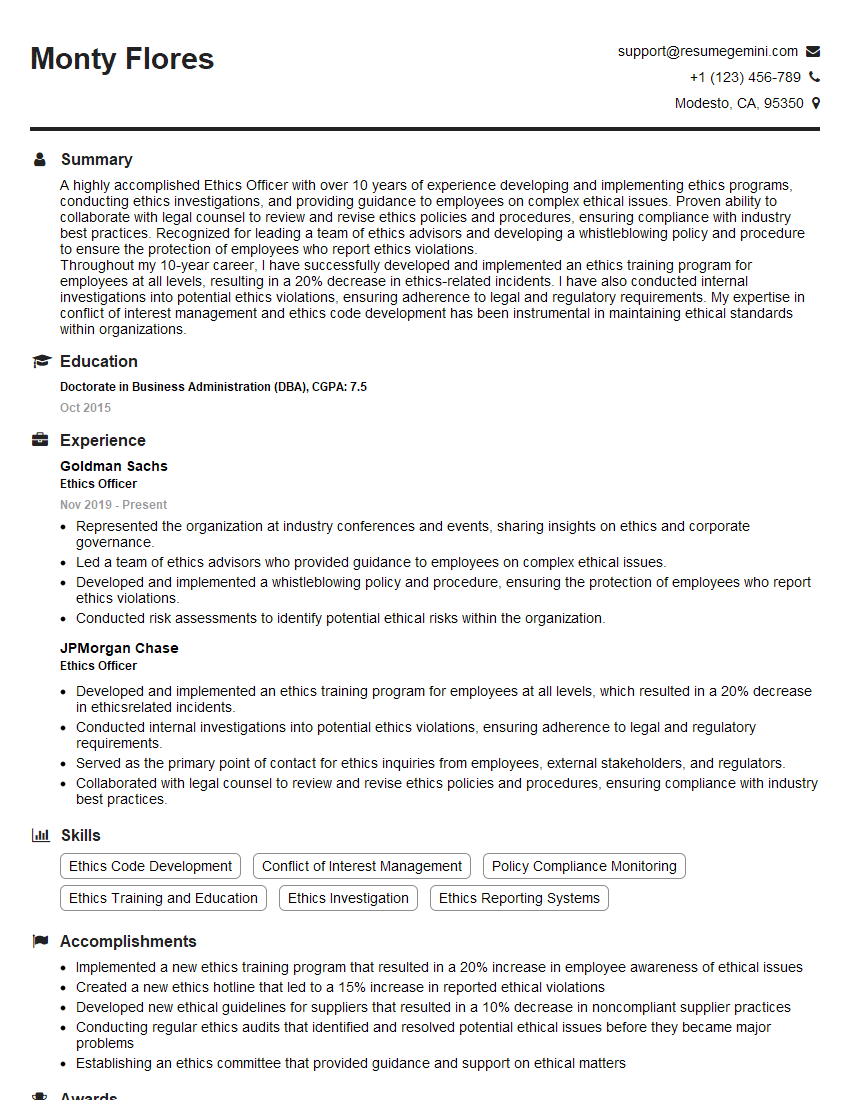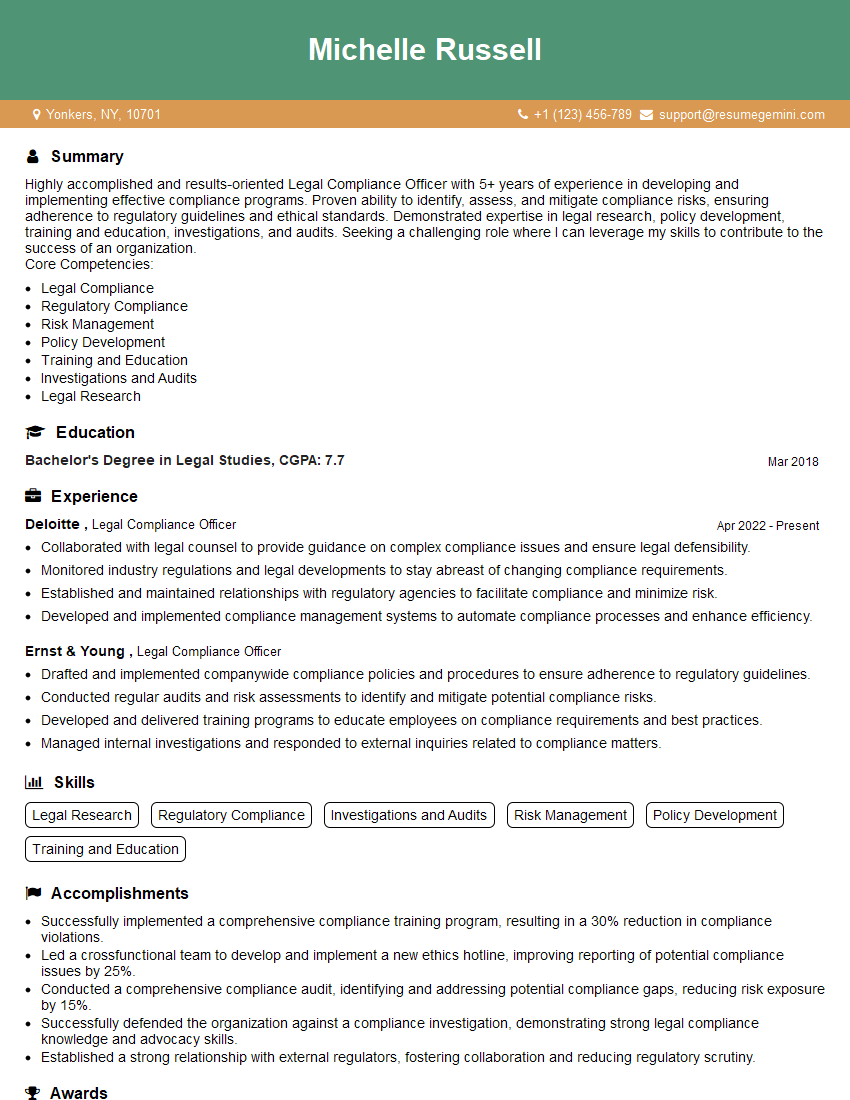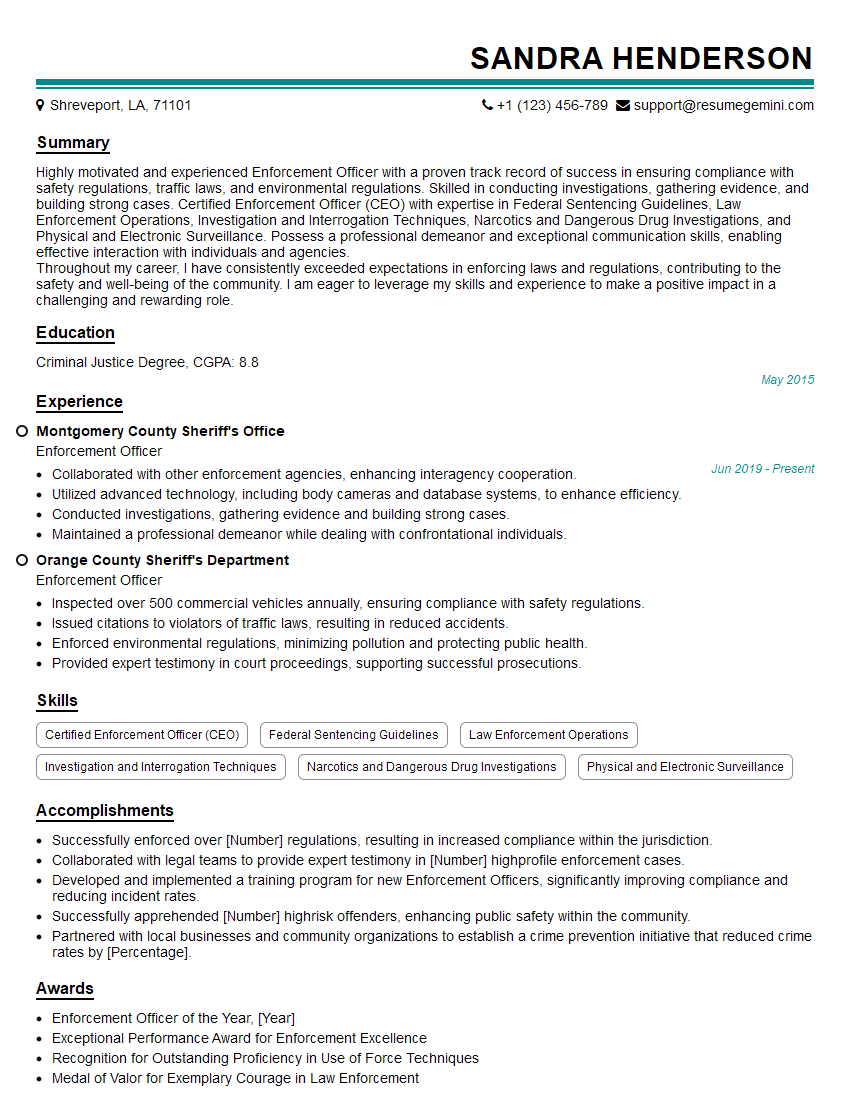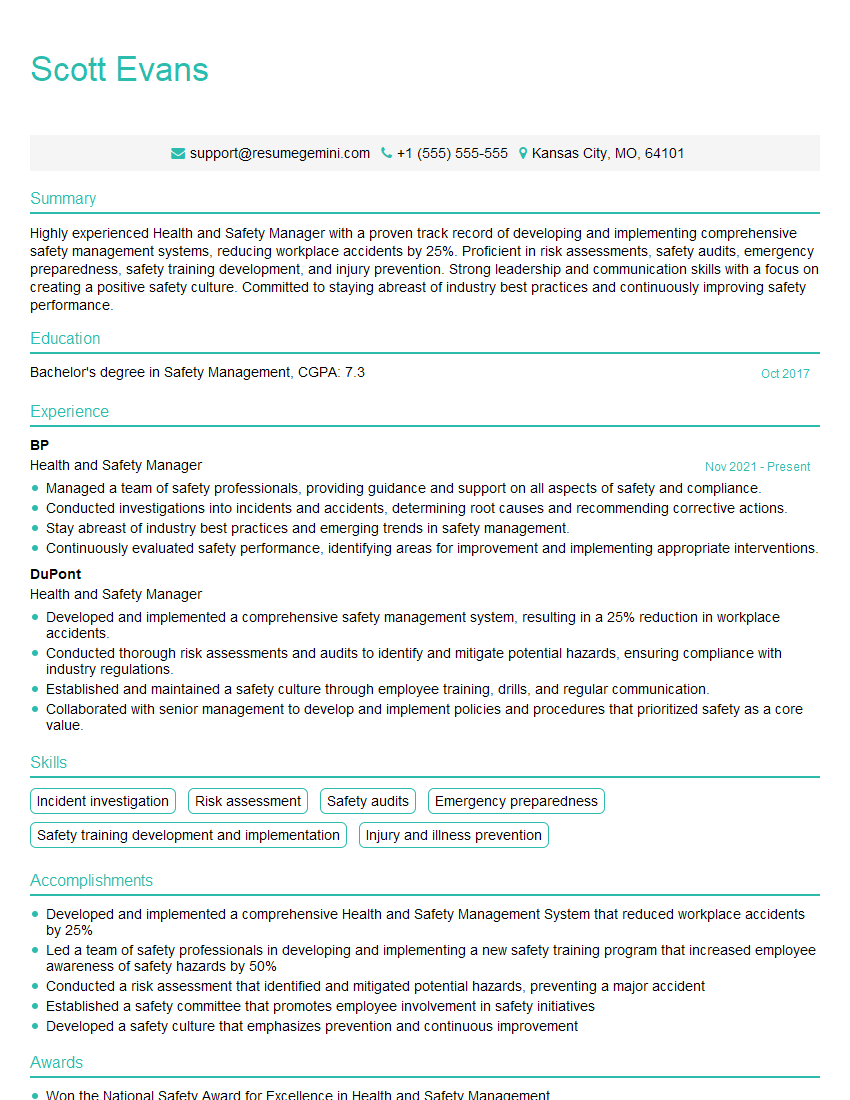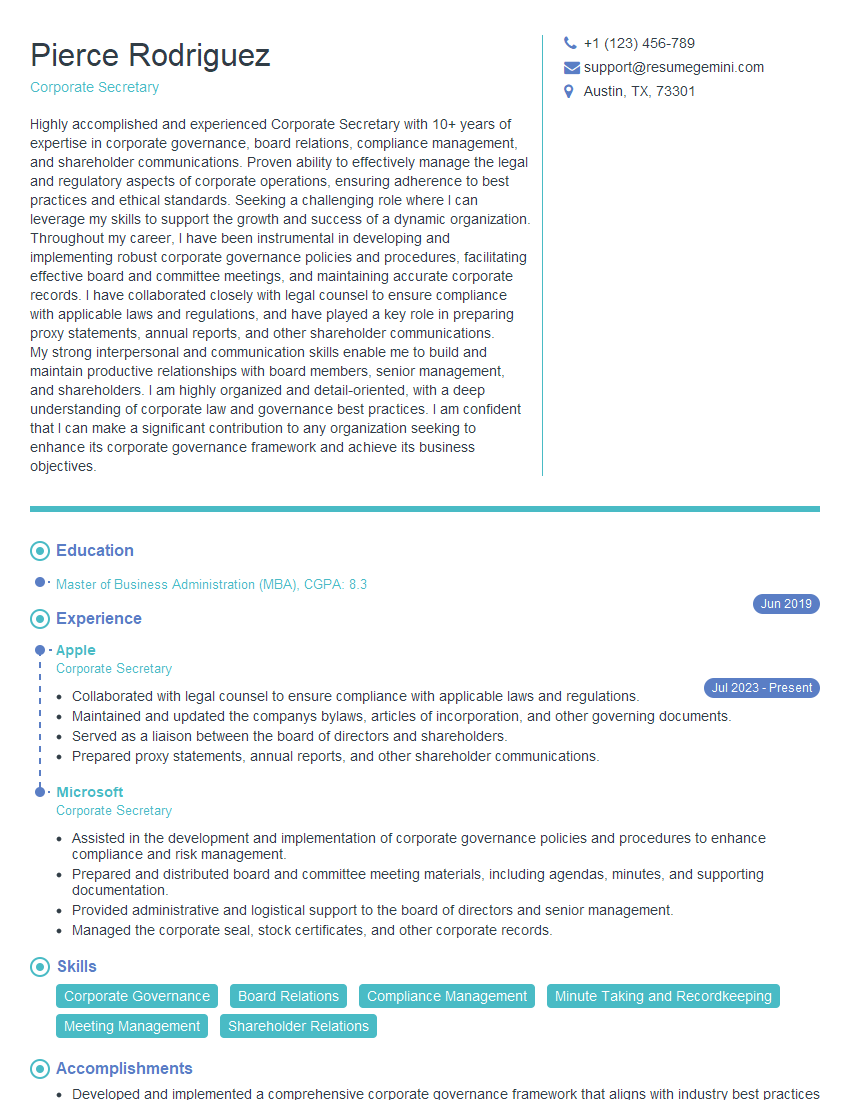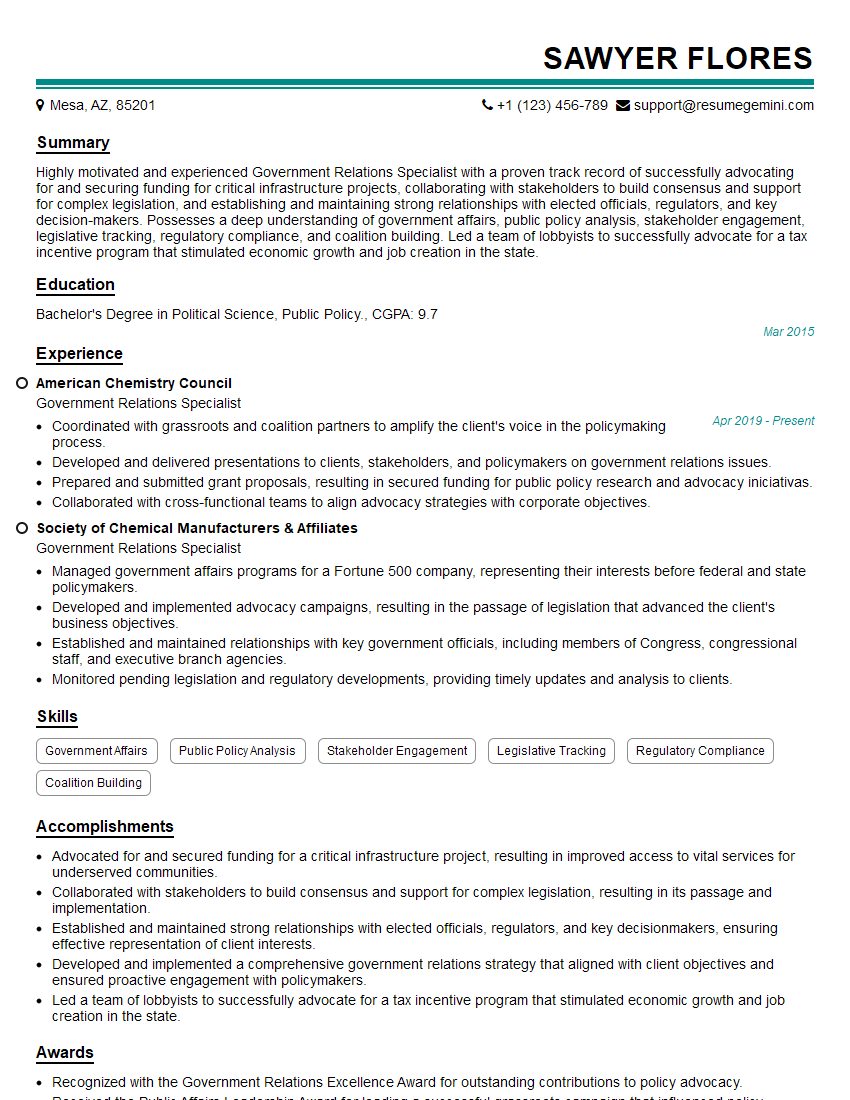Feeling uncertain about what to expect in your upcoming interview? We’ve got you covered! This blog highlights the most important Knowledge of Local Operating Rules interview questions and provides actionable advice to help you stand out as the ideal candidate. Let’s pave the way for your success.
Questions Asked in Knowledge of Local Operating Rules Interview
Q 1. Explain the difference between local ordinances and state regulations.
Local ordinances and state regulations are both sets of rules governing activities within a specific geographic area, but they differ significantly in scope and authority. Think of it like this: state regulations are the broad strokes, while local ordinances are the detailed brushwork within a specific community.
State Regulations: These are laws passed by a state legislature and apply statewide. They often address broad issues like environmental protection, building codes (setting minimum standards), and public health. For instance, a state might have regulations mandating specific fire safety systems in all commercial buildings.
Local Ordinances: These are laws passed by local governing bodies (city councils, county commissions) and apply only within their jurisdiction. They often address more specific local concerns. A city might have an ordinance restricting the hours of operation for businesses in a residential area, or specifying landscaping requirements for commercial properties. Local ordinances can be *more* restrictive than state regulations, but they cannot contradict state law.
In essence, state regulations establish a baseline, while local ordinances tailor those regulations to meet the unique needs and characteristics of a particular community.
Q 2. Describe your experience navigating complex local permitting processes.
I have extensive experience navigating complex local permitting processes, particularly in the context of commercial construction projects. One recent project involved obtaining permits for a new restaurant in a historic district. This required navigating multiple layers of approvals: building permits from the city, sign permits, liquor licenses, and even historical preservation board approvals, each with its own unique application process, deadlines, and requirements.
My approach involved:
- Thorough Due Diligence: I started by meticulously researching all applicable codes and regulations, identifying every permit needed. This included consulting the city’s website, meeting with planning department staff, and reviewing relevant ordinances.
- Proactive Communication: I maintained consistent and open communication with the various city departments throughout the process, anticipating potential roadblocks and addressing them early.
- Detailed Application Preparation: Applications were meticulously completed, including all required documentation and plans, ensuring they were error-free and met all specifications.
- Problem Solving: There were several unexpected delays. For example, a minor discrepancy in the building plans required an amendment and a further review. I addressed this swiftly, proactively engaging with the building inspector to find a timely solution.
Successfully navigating this complex process hinged on my organizational skills, proactive communication, and deep understanding of local regulations.
Q 3. How do you stay updated on changes to local operating rules?
Staying updated on changes to local operating rules requires a multi-pronged approach.
- Official Website Monitoring: I regularly check the websites of the relevant local government agencies (city, county) for updates, notices, and newly adopted ordinances.
- Subscription to Notifications: Many municipalities offer email alerts or RSS feeds for updates on ordinances and regulatory changes. I utilize these to receive timely notifications.
- Professional Networks: I actively engage in professional organizations and networks that focus on local government and land use planning. This provides access to information and discussions about regulatory changes.
- Attending Public Meetings: Occasionally I attend public hearings and council meetings to stay abreast of proposed changes and participate in discussions.
- Working with Legal Counsel: For complex regulations, or when significant changes are expected, consulting with legal counsel experienced in local government regulations offers added assurance.
This combination of proactive measures helps maintain awareness of changes and ensure compliance.
Q 4. What’s your approach to ensuring compliance with local safety regulations?
Ensuring compliance with local safety regulations is paramount. My approach involves a three-step process.
- Proactive Risk Assessment: I conduct thorough risk assessments at the start of any project to identify potential safety hazards and determine the relevant regulations.
- Implementation of Safety Measures: Based on the risk assessment, I implement safety measures that exceed minimum regulatory requirements whenever possible. This often involves consultation with safety professionals and utilizing industry best practices.
- Regular Audits and Inspections: Routine inspections and audits are conducted throughout the project lifecycle to monitor compliance, identify any emerging issues, and rectify them promptly. This includes collaborating with relevant authorities for scheduled inspections.
This systematic approach minimizes risks and ensures a safe working environment, aligning with both legal and ethical responsibilities.
Q 5. Describe a situation where you identified a violation of local operating rules. How did you handle it?
During a construction project, I noticed a neighboring business was operating outside the permitted hours stipulated in the local noise ordinance. This posed a potential disruption to our project and created concerns about compliance.
My approach was to:
- Document the Violation: I documented the instances of noise violation, including dates, times, and the nature of the disturbance.
- Consult Local Regulations: I reviewed the exact wording of the noise ordinance to be certain of the violation.
- Professional and Diplomatic Contact: I contacted the business owner directly, explaining the situation professionally and emphasizing the impact on the nearby construction work. I focused on mutual cooperation rather than confrontation.
- Escalation if Necessary: When the issue persisted despite friendly communication, I contacted the appropriate city department to report the violation, providing the documented evidence.
The issue was ultimately resolved amicably, demonstrating that effective communication and a documented approach can resolve violations without unnecessary conflict.
Q 6. How familiar are you with the relevant local zoning regulations?
I am very familiar with relevant local zoning regulations. My experience includes working with zoning maps, understanding zoning classifications (residential, commercial, industrial, etc.), and interpreting zoning codes to determine permitted uses, building setbacks, height restrictions, and parking requirements. I understand the process of applying for zoning variances and appeals when necessary.
This understanding is crucial for ensuring projects align with local land use plans and avoid costly delays or legal challenges.
Q 7. Explain how you would ensure a project complies with all applicable local rules and regulations.
Ensuring a project complies with all applicable local rules and regulations is a systematic process.
- Comprehensive Regulatory Research: This involves a thorough review of all relevant codes, ordinances, and regulations at the local, county, and potentially state levels.
- Detailed Project Planning: During the planning phase, the project design is meticulously reviewed against the identified regulations. This involves close collaboration with architects, engineers, and other professionals.
- Permit Acquisition: All necessary permits and approvals are obtained before commencing any work. This ensures that the project complies with building codes, zoning regulations, and environmental requirements.
- Ongoing Compliance Monitoring: Throughout the project lifecycle, regular checks are conducted to verify continuous compliance with regulations. This includes inspections, documentation, and record-keeping.
- Documentation and Record Keeping: Maintaining thorough documentation is vital. This includes all permits, approvals, inspection reports, and any correspondence with regulatory authorities.
By following this process, potential issues are identified and addressed proactively, preventing costly delays and legal complications. This approach ensures the project is completed legally and safely.
Q 8. How do you balance efficiency with compliance when following local operating rules?
Balancing efficiency and compliance with local operating rules requires a strategic approach. It’s not about choosing one over the other, but rather finding the optimal intersection. Think of it like navigating a city: you want to reach your destination quickly (efficiency), but you must also follow traffic laws (compliance). Failure to do so can lead to delays, accidents (fines, penalties), or even being completely stopped (business closure).
My strategy involves a three-pronged approach:
- Proactive Compliance: Before any operation, I thoroughly research and understand all relevant local rules. This includes zoning regulations, permits, environmental guidelines, and safety standards. I create checklists and detailed plans to ensure all steps comply.
- Streamlined Processes: Once compliant, I look for ways to optimize workflows without compromising adherence to regulations. This might involve automation, improved communication, or better resource allocation. For example, using software to automatically track permits and renewals ensures timely compliance and prevents potential delays.
- Continuous Monitoring and Improvement: Regular audits and reviews are vital to identify areas for improvement. We track key metrics (e.g., permit processing time, number of compliance incidents) to measure efficiency and identify potential compliance gaps. This iterative process allows us to continuously refine our approach.
Q 9. Describe your understanding of environmental regulations at the local level.
My understanding of local environmental regulations is multifaceted and goes beyond simply knowing the rules; it’s about understanding their rationale and implications. Local environmental regulations are designed to protect the local ecosystem and public health, covering areas such as waste disposal, air and water quality, noise pollution, and land use. These rules vary widely depending on the geographic location and its specific environmental challenges. For instance, a coastal city might have stringent regulations on wastewater discharge to protect marine life, while an inland city might focus on air quality due to industrial activity.
These regulations often involve obtaining permits, adhering to specific emission standards, and conducting environmental impact assessments before initiating projects. Failure to comply can result in significant fines, legal action, and reputational damage. I’m familiar with navigating the specific permitting processes and understanding environmental assessments needed for various projects.
Q 10. What strategies do you use to identify and mitigate potential risks related to local rules?
Identifying and mitigating risks associated with local rules involves a proactive, systematic approach. I use a risk assessment framework that involves:
- Identifying Potential Risks: This includes reviewing all applicable local ordinances, consulting with legal and environmental experts, and analyzing historical compliance data for similar projects. I use checklists and flowcharts to document this process.
- Assessing Risk Likelihood and Impact: For each identified risk, I evaluate the probability of it occurring and the potential consequences. This allows prioritization of mitigation efforts, focusing on high-impact, high-likelihood risks first.
- Developing Mitigation Strategies: These strategies can include implementing stricter control measures, obtaining additional permits, investing in safety equipment, and developing detailed contingency plans for potential incidents. I ensure these strategies are documented and communicated to all relevant parties.
- Monitoring and Review: Regular monitoring of the effectiveness of mitigation strategies is vital. We conduct periodic reviews to identify emerging risks and adapt our strategies as necessary.
For example, if a project involves potentially hazardous materials, a detailed risk assessment will identify the handling, storage, and disposal procedures needed, and establish protocols to prevent accidents and spills.
Q 11. How would you handle a conflict between a company policy and a local operating rule?
Conflicts between company policy and local operating rules require careful consideration and a solution that prioritizes legal compliance. The fundamental principle is that local laws always supersede company policies. This is non-negotiable. Ignoring local regulations can lead to serious legal and financial consequences for the company.
My approach involves:
- Clearly Identifying the Conflict: The first step is documenting the precise conflict, referencing the specific company policy and the relevant local rule.
- Seeking Legal Counsel: Consulting with legal professionals specializing in local regulations is crucial. They can provide expert advice on navigating the conflict and ensuring compliance.
- Negotiation and Compromise: If possible, we explore options to modify the company policy to align with local regulations while preserving operational efficiency as much as possible. This may involve discussions with local authorities.
- Prioritizing Compliance: If negotiation isn’t feasible, the company policy must be adjusted to comply with the local rule. This demonstrates respect for the local jurisdiction and minimizes the risk of penalties.
Q 12. What are some common challenges in ensuring compliance with local operating rules?
Ensuring compliance with local operating rules presents several challenges:
- Frequent Changes in Regulations: Local regulations can change frequently, requiring constant monitoring and updates to ensure compliance. Staying informed is essential.
- Complexity and Ambiguity: Some regulations can be complex, ambiguous, or difficult to interpret. This necessitates careful review and potentially seeking expert legal advice.
- Resource Constraints: Compliance efforts require resources – time, personnel, and funding. Balancing compliance with other business priorities can be challenging.
- Lack of Awareness: Employees may lack awareness of all applicable rules, leading to unintentional non-compliance. Training and clear communication are vital.
- Enforcement Variability: Enforcement of regulations can vary across different jurisdictions or even within the same jurisdiction over time. This can make predicting outcomes difficult.
Q 13. How do you communicate complex local regulations to non-technical stakeholders?
Communicating complex local regulations to non-technical stakeholders requires simplifying complex information without sacrificing accuracy. I use a multi-pronged approach:
- Plain Language Summaries: I translate complex legal language into clear, concise summaries. I avoid jargon and use visual aids like flowcharts or diagrams to explain processes.
- Interactive Training Sessions: Interactive sessions with Q&A allow for direct engagement and clarification of doubts. Real-world examples and scenarios help to make the information relatable.
- Visual Aids and Infographics: Visual representations of complex information significantly enhance understanding and knowledge retention. Infographics can summarize key rules and responsibilities.
- Regular Check-ins and Updates: Regular communication keeps stakeholders informed about any changes or updates to regulations. This helps to prevent confusion and ensure ongoing compliance.
For example, instead of explaining zoning regulations with legal jargon, I might use a map to visually demonstrate permitted land use in different zones.
Q 14. Describe your experience working with local government agencies.
I have extensive experience working with local government agencies, including building departments, environmental protection agencies, and planning commissions. This experience includes:
- Obtaining permits and licenses: I have successfully navigated the processes for obtaining various permits and licenses, ensuring all requirements are met and applications are submitted correctly.
- Participating in public hearings and meetings: I’ve represented my organization in public hearings, effectively communicating our position and addressing concerns from local authorities and community members.
- Collaborating on development projects: I have worked closely with local government agencies on various projects, ensuring our plans comply with local regulations and addressing any concerns proactively.
- Addressing compliance issues: I have experience addressing compliance issues with local agencies, working collaboratively to find solutions that satisfy both parties while ensuring regulatory compliance.
These interactions have allowed me to develop strong working relationships with local government officials, fostering open communication and a collaborative approach to ensuring regulatory compliance.
Q 15. How would you handle a situation where local regulations are ambiguous or unclear?
Ambiguity in local regulations is a common challenge. My approach involves a multi-step process. First, I’d meticulously review all available documentation – ordinances, permits, guidelines, and any relevant case law. Second, if clarity remains elusive, I’d proactively seek clarification from the relevant regulatory authority. This might involve submitting a formal inquiry, attending public meetings, or consulting with legal counsel specializing in the area. Third, I’d maintain detailed records of my inquiries and the responses received, documenting the steps taken to interpret the regulations. For example, if a zoning ordinance regarding building heights is unclear, I would contact the city’s planning department directly to get a definitive interpretation before proceeding with a project. This proactive approach minimizes risk and ensures compliance.
Career Expert Tips:
- Ace those interviews! Prepare effectively by reviewing the Top 50 Most Common Interview Questions on ResumeGemini.
- Navigate your job search with confidence! Explore a wide range of Career Tips on ResumeGemini. Learn about common challenges and recommendations to overcome them.
- Craft the perfect resume! Master the Art of Resume Writing with ResumeGemini’s guide. Showcase your unique qualifications and achievements effectively.
- Don’t miss out on holiday savings! Build your dream resume with ResumeGemini’s ATS optimized templates.
Q 16. How do you document compliance with local operating rules?
Documenting compliance is crucial for demonstrating due diligence. My strategy involves creating a comprehensive compliance management system. This typically includes maintaining a central repository of all relevant regulations, along with evidence of our adherence. This could range from signed permits and inspection reports to internal checklists, training records, and meeting minutes. We might also employ a version control system for regulatory documents to track changes over time. For instance, if we have a permit to operate a food processing plant, the system would hold a digital copy of that permit, inspection reports, and any training certificates for staff on food safety regulations. Regular reviews of this documentation are essential, not only for compliance but also for continuous improvement of our processes.
Q 17. What metrics do you use to track compliance with local regulations?
Tracking compliance goes beyond simply having the right documents; it requires measuring our performance against those regulations. Key metrics include the number of incidents, violations, or non-conformances detected. We also track the time taken to resolve such issues and the effectiveness of corrective actions. Furthermore, we monitor the frequency and effectiveness of internal audits and employee training programs. For instance, if we aim to reduce safety incidents in our manufacturing plant, we’d track the number of incidents per month, the root causes, and the outcomes of any investigations. These data points help us to pinpoint areas for improvement and demonstrate our ongoing commitment to compliance.
Q 18. How would you incorporate local operating rules into a new project plan?
Integrating local operating rules into a project plan requires a systematic approach. First, we’d identify all relevant regulations early in the project planning phase, allocating sufficient time and resources for compliance activities. This involves a thorough review of applicable regulations, potentially using specialized software to help identify and categorize relevant legislation. Second, we’d assign responsibility for compliance to specific team members, embedding compliance checks into the project timeline. Finally, we’d incorporate potential compliance costs and delays into the project budget and schedule. For example, if a project involves building a new facility, we’d consult zoning ordinances and environmental regulations at the outset to determine potential permits required and their associated timelines, budgeting appropriately for these delays and costs.
Q 19. Describe your experience with conducting internal audits to ensure compliance.
My experience with internal audits includes leading and participating in numerous audits across various industries. Our audits follow a structured methodology, starting with planning and scoping, which involves identifying critical areas based on risk assessment. The auditing process itself is thorough, involving document reviews, site inspections, and interviews with personnel. We use standardized checklists and audit tools to ensure consistency and objectivity. After the audit, a report is generated, highlighting findings and recommending corrective actions. We also conduct follow-up audits to verify that corrective actions have been implemented effectively. For example, in a recent audit of a manufacturing facility, we identified a lapse in safety protocols that led to a recommendation for enhanced employee training, followed by a follow-up audit to confirm that the improved safety procedures were in place and effective.
Q 20. How do you identify potential changes in local operating rules that could impact your work?
Identifying changes in local operating rules demands a proactive and vigilant approach. We use multiple methods, including regularly monitoring official government websites, subscribing to relevant industry newsletters, and attending local government meetings and workshops. We also maintain relationships with regulatory agencies to receive updates directly. Moreover, we can utilize specialized software and services that track legislative changes and provide alerts for relevant updates. Staying informed ensures that we adapt to evolving regulations promptly and prevent potential non-compliance. For example, if the environmental protection agency changes regulations on waste disposal, our team will be immediately notified through our monitoring system and we can quickly update our operational procedures accordingly.
Q 21. Explain how technology can aid in ensuring compliance with local regulations.
Technology plays a critical role in ensuring compliance. Software solutions can automate tasks such as document management, tracking regulatory changes, conducting risk assessments, and generating compliance reports. These solutions streamline the compliance process, reducing manual effort and increasing efficiency. For instance, a compliance management software can automatically alert us of an impending deadline for permit renewal, reducing the risk of non-compliance. Data analytics can also be used to identify trends and patterns in compliance data, highlighting areas that require attention. Geographic Information Systems (GIS) can be used to visualize compliance data spatially, allowing for a more targeted and efficient approach. The integration of these technologies significantly improves the effectiveness and efficiency of compliance programs.
Q 22. What is your understanding of the penalties for non-compliance with local operating rules?
Penalties for non-compliance with local operating rules vary significantly depending on the specific rule violated, the jurisdiction, and the severity of the infraction. Generally, penalties can range from relatively minor fines for administrative issues to substantial financial penalties, operational shutdowns, legal action, and even criminal charges for serious violations like those impacting public safety or environmental protection.
For example, a small business might face a fine for not properly displaying its operating license, while a construction company could face a much larger fine, work stoppage, and legal repercussions for violating safety regulations leading to a workplace accident. The severity is often determined by factors such as the potential harm caused, the intent of the violation (was it accidental or willful?), and the history of compliance by the business. It’s crucial to stay informed about specific penalties through regular review of local ordinances and consultation with relevant regulatory bodies.
- Fines: Varying amounts based on the infraction.
- Operational Shutdowns: Temporary or permanent closure of operations.
- Legal Action: Lawsuits, injunctions, and other legal proceedings.
- Criminal Charges: In cases of serious negligence or willful violation.
Q 23. How familiar are you with the local building codes in your area?
My familiarity with local building codes is extensive. I regularly consult and stay updated on the codes applicable to my area, including those related to structural integrity, fire safety, electrical systems, plumbing, accessibility, and environmental concerns. I understand that these codes are regularly updated, so I actively monitor changes and participate in relevant training and professional development opportunities to maintain my expertise. I’m proficient in interpreting code language and applying them to various projects, ensuring all designs and constructions adhere to all necessary regulations. My knowledge also extends to understanding the permitting process and how to navigate any potential variances or appeals related to the local building codes.
For instance, recently I had to ensure that a renovation project incorporated the latest energy efficiency standards mandated by the updated building codes. This involved not only understanding the specific requirements but also navigating the permit application process and demonstrating compliance to the building inspectors.
Q 24. How would you integrate local operating rules into a training program for new employees?
Integrating local operating rules into a new employee training program is crucial for ensuring compliance and minimizing risk. My approach would involve a multi-faceted strategy:
- Interactive Modules: Develop online modules using interactive scenarios and quizzes to assess understanding. This ensures engagement and retention.
- On-the-Job Training: Pair new employees with experienced staff to demonstrate practical application of rules. This hands-on approach is valuable for learning nuances.
- Role-Playing Exercises: Simulate scenarios where employees must apply their knowledge to real-life situations. This promotes critical thinking and problem-solving skills.
- Regular Quizzes and Tests: Use regular assessments to reinforce learning and identify knowledge gaps. This facilitates prompt corrective action.
- Reference Materials: Provide easily accessible, up-to-date copies of all relevant codes and guidelines. This allows for quick reference during work.
- Compliance Updates: Regularly update the training program to reflect changes in local operating rules. This ensures employees are always abreast of current regulations.
The goal is to move beyond simple memorization to a deeper understanding of *why* rules are in place, fostering a culture of proactive compliance.
Q 25. Describe your experience with risk assessments related to local regulations.
I have extensive experience conducting risk assessments related to local regulations. This involves a systematic process of identifying potential hazards, evaluating their likelihood and severity, and implementing control measures to mitigate risks. My approach typically follows these steps:
- Identify potential hazards: This involves reviewing relevant local operating rules, industry best practices, and past incident reports to pinpoint potential areas of non-compliance.
- Assess the likelihood and severity: This involves assigning probabilities and consequences to each hazard to determine its risk level. A risk matrix is often used for this purpose.
- Implement control measures: This involves developing and implementing strategies to reduce or eliminate identified risks, ranging from administrative controls to engineering controls and personal protective equipment.
- Monitor and review: This involves regularly monitoring the effectiveness of implemented controls and updating the risk assessment as needed. This often incorporates regular internal audits and external inspections.
For example, in a recent risk assessment for a construction project, we identified the risk of falls from height. This led to the implementation of strict fall protection measures, such as harness systems and guardrails, along with specific training programs for employees. The effectiveness of these controls was then continuously monitored through regular inspections and incident reporting.
Q 26. How do you ensure that subcontractors also comply with local operating rules?
Ensuring subcontractor compliance is vital for overall operational compliance. My approach involves several key strategies:
- Thorough Vetting: Before engaging a subcontractor, I verify their licensing, insurance, and past compliance record with local operating rules. References are checked.
- Contractual Obligations: Subcontracts clearly outline compliance requirements, holding subcontractors accountable for adhering to all applicable regulations. This includes penalties for non-compliance.
- Regular Monitoring: I conduct regular site visits and inspections to ensure subcontractors are meeting the stipulated standards. This often includes reviewing their safety records and work practices.
- Training and Communication: Subcontractors receive clear instructions and training regarding relevant local operating rules and our company’s expectations. This ensures everyone is on the same page.
- Incident Reporting: Subcontractors are obligated to report any incidents or near misses immediately, facilitating prompt corrective action.
This proactive approach ensures that the entire project team is aligned on compliance, minimizing risk and ensuring a safe and productive work environment.
Q 27. What is your experience with reporting violations of local operating rules?
Reporting violations of local operating rules is a critical responsibility. My experience involves a structured approach:
- Immediate Documentation: Thoroughly document any observed violations, including date, time, location, details of the violation, and any potential witnesses.
- Internal Review: Internally review the violation to assess the severity and potential impact. This often involves consulting with legal counsel.
- Formal Reporting: Report the violation to the appropriate regulatory agency according to their specified procedures. This might involve submitting a written report or filing an online complaint.
- Follow-up: Follow up with the regulatory agency on the status of the investigation and any resulting actions. This could also involve follow-up with our internal team or subcontractor involved to ensure corrective actions are taken.
- Record Keeping: Maintain detailed records of all reported violations, responses received from regulatory agencies, and any corrective actions taken. This is vital for future reference and auditing.
Transparency and prompt action are essential in maintaining regulatory compliance and upholding ethical business practices.
Q 28. How do you prioritize compliance tasks amidst competing operational demands?
Prioritizing compliance tasks amidst competing operational demands requires a strategic approach. I utilize a risk-based prioritization framework:
- Risk Assessment: Conduct a risk assessment to identify potential compliance risks, evaluating the likelihood and severity of each potential violation. Higher-risk areas receive higher priority.
- Regulatory Deadlines: Compliance tasks with imminent deadlines are prioritized to avoid penalties or disruptions.
- Impact on Operations: Compliance tasks that have a significant impact on operational efficiency or productivity are given higher priority.
- Resource Allocation: Allocate resources effectively based on the prioritized tasks. This might involve assigning personnel and allocating budget accordingly.
- Regular Review: Regularly review the prioritization of tasks and adjust as needed based on changing circumstances or new information.
Think of it like a triage system in a hospital – the most critical cases receive immediate attention, while others are addressed based on urgency and severity. This allows for efficient management of competing demands while ensuring critical compliance tasks are not neglected.
Key Topics to Learn for Knowledge of Local Operating Rules Interview
- Understanding the Regulatory Framework: Grasp the underlying legal and regulatory principles governing local operations. This includes familiarity with relevant legislation, codes, and compliance standards.
- Practical Application of Rules: Demonstrate your ability to apply these rules in real-world scenarios. Consider examples where you’ve had to interpret and follow specific regulations, and be prepared to discuss the implications of non-compliance.
- Emergency Procedures and Protocols: Familiarize yourself with established emergency response plans and procedures. Be ready to discuss how you would react in various emergency situations, ensuring adherence to all relevant local operating rules.
- Safety Regulations and Best Practices: Understand and be able to articulate safety regulations specific to your industry and location. This includes workplace safety, environmental protection, and any other relevant safety protocols.
- Record Keeping and Documentation: Be prepared to discuss the importance of accurate and timely record-keeping related to local operating rules compliance. Understand the processes for maintaining these records and their potential use in audits or investigations.
- Problem-Solving and Conflict Resolution: Develop your ability to analyze situations where local operating rules may conflict or present challenges. Practice identifying solutions that balance compliance with operational efficiency and safety.
- Continuous Improvement and Updates: Show awareness of the dynamic nature of regulations. Demonstrate your understanding of how to stay informed about updates and changes to local operating rules and their impact on your work.
Next Steps
Mastering Knowledge of Local Operating Rules is crucial for career advancement in your field. A strong understanding of these rules demonstrates your commitment to compliance, safety, and efficiency – qualities highly valued by employers. To significantly boost your job prospects, focus on creating an ATS-friendly resume that highlights your relevant skills and experience. ResumeGemini is a trusted resource that can help you build a professional and impactful resume. We provide examples of resumes tailored to highlight expertise in Knowledge of Local Operating Rules to help you present yourself in the best possible light.
Explore more articles
Users Rating of Our Blogs
Share Your Experience
We value your feedback! Please rate our content and share your thoughts (optional).
What Readers Say About Our Blog
Hi, I’m Jay, we have a few potential clients that are interested in your services, thought you might be a good fit. I’d love to talk about the details, when do you have time to talk?
Best,
Jay
Founder | CEO
